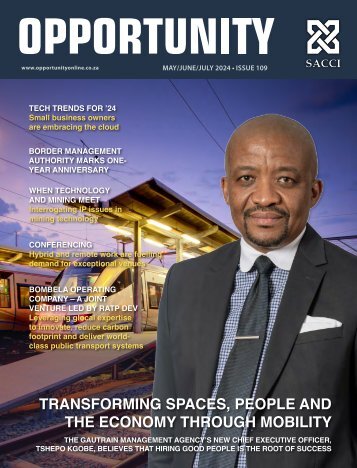South African Business 2016 edition
- Text
- Investment
- Government
- Business
- Development
- Network
- Sectors
- Investing
- Business
- Africa
- African
- Economic
- Manufacturing
- Mining
- Opportunities
- Economy
- Overview
The powerhouse of Africa
The powerhouse of Africa Mpumalanga offers a strategic location in the world market, along with modern infrastructure, sophisticated fi nancial markets and cutting-edge technology. The diverse, cost-effi cient mineral and agro-industry inputs, world-class telecommunications and information industry, rapid liberalization of trade and investment market and a government commitment to investment facilitation all combine to create an unparalleled quality of life in the Province. The South African Province of Mpumalanga’s diverse and resource-rich economy, coupled with its people’s indomitable spirit, makes it one of the most attractive Trade and Investment destinations in South-East Africa. Good access to East African and Indian Ocean Rim Markets Preferential access to the lucrative EU market Part of SADC – 280- million consumers Located next to Port of Maputo More than 80% of South Africa’s coal is sourced in Mpumalanga. Mpumalanga AN IDEAL POSITION Situated in the north-east of South Africa, Mpumalanga province shares a common border with the independent Republics of Mozambique and Swaziland and has a population of 4.1-million people and a total area of 83 000km 2 . In addition to its capital, Mbombela, the Province has a number of major cities including eMalahleni, Middleburg and Secunda which host some of the major industrial complexes of South Africa. The Gross Geographic Product (GGP) of the Mpumalanga Province is US-billion (2013). Mpumalanga’s position and resources make it a valuable transport and logistics hub The province’s three biggest sectors are manufacturing, mining and agriculture. COMMUNITY SERVICE 16% MINING 25% MPUMALANGA’S ECONOMIC DIVERSITY The economic diversity of Mpumalanga is supported by world-class infrastructure, which makes the Province a unique investment destination in South East Africa. Mpumalanga shares a border with 4 provinces and 2 independent countries TRADE 15% UTILITIES 5% CONSTRUCTION 3% AGRICULTURE 3% MANUFACTURING 13% FINANCE 12% TRANSPORT 6% 19 000 000 19m tons of cargo per year moves through the Maputo Corridor. . 0-rated Bulk cargo & transhipments are now zerorated in Mozambique. R4.9-billion The value of investment in Port of Maputo (160 SMMEs employed). . 2027 The year the investment contract in Maputo port is up for renewal. 11% Maputo Corridor truck traffi c increases at an annual rate of 10-11%. 90 000pa Number of trucks that cross the Lebombo border into Mozambique.
Economic diversity: Investment opportunities The Provincial economy of Mpumalanga is exceptionally diverse. Established industries in the Province include Mining, Stainless Steel, Petro-Chemicals, Pulp and Paper, Ferro-Alloys, Tourism and Agro-Processing, amongst others. A wide range of raw materials and feedstocks are available for benefi ciation. • Mpumalanga Province was the one of the main contributors to the national economy in 2014, together with Gauteng (34.6%), KwaZulu-Natal (15.9%) and the Western Cape (13.7%). • The major components of the economy are mining, manufacturing, agriculture (which includes forestry and fishing operations) and tourism (part of which is included in the trade sector). • A significant contributor to the economy is the power-generation industry that operates within the utilities sector and accounts for some 96% of the sector. Mpumalanga is the third-largest coal-exporting region in the world INVESTMENT OPPORTUNITIES SECTORS, INDUSTRIES AND PRODUCTS THAT CAN BE BENEFICIATED MANUFACTURING STAINLESS STEEL Cutlery Catering Equipments Surgical instruments Automotive components STEEL White & grey goods Pipes & tubes Wire PETRO-CHEMICALS Plastic products Recycling plastics Artifi cial rubber products Paint & vanish Inks & dyes FOOD PROCESSING Maize meal Machinery Frozen & dehydrated vegetables Preserves pickles & condiments Nuts PAPER Recycling SUGAR Confectionery MINING Machinery and services RENEWABLE ENERGY Solar and bio-fuel Biomass MINING COAL Waste briquettes GOLD JEWELLERY CHROME PLATINUM IRON ORE VANADIUM MANGANESE GRANITE Building cladding & tombstone CLAY Porcelain & ceramics Electrical insulators FORESTRY Beneficiation of timber products Builders hardware Furniture TOURISM Tourism infrastructure various grades of accommodation Infrastructure, hotels & lodges AGRICULTURE SUMMER CEREALS & LEGUMES MAIZE Maize meal SOYA Meal, Edible oil CANOLA Edible oil SUN FLOWER Edible oil TROPICAL & SUBTROPICAL FRUIT CANE SUGAR Sugar / confectionery CITRUS Juice & concentrate MANGOES Dried, frozen, juice & concentrates LITCHIS Dried, frozen, juice & concentrates AVOCADOES Avocado oil GUAVA Dried, frozen, juice & concentrates MACADAMIA NUTS Processed & confectionery
- Page 1:
SOUTH AFRICAN BUSINESS 2016 EDITION
- Page 6:
CONTENTS Introduction CONTENTS Sout
- Page 10 and 11:
CREDITS Publisher Chris Whales Publ
- Page 12 and 13:
SPECIAL FEATURE South Africa A peri
- Page 14 and 15:
SPECIAL FEATURE In a year that saw
- Page 16 and 17:
SPECIAL FEATURE owes its existence
- Page 18 and 19:
SPECIAL FEATURE against water losse
- Page 20 and 21:
SPECIAL FEATURE Operation Phakisa h
- Page 22 and 23:
SPECIAL FEATURE late in 2014. The h
- Page 24 and 25:
SPECIAL FEATURE Understanding Afric
- Page 26 and 27:
INTERVIEW Job creation on track Ala
- Page 28 and 29:
SPECIAL FEATURE Business funding Th
- Page 30 and 31:
SPECIAL FEATURE in turn makes it ve
- Page 32 and 33:
SPECIAL FEATURE Contact: 012 394 18
- Page 34 and 35:
SPECIAL FEATURE Black Business Supp
- Page 36 and 37:
SPECIAL FEATURE The evolution of sk
- Page 38:
SPECIAL FEATURE providing TVET lear
- Page 42:
PROFILE FP&M Seta Facilitating and
- Page 45 and 46:
• The development of a national s
- Page 48 and 49:
FOCUS Champions of change Five dyna
- Page 50 and 51:
SPECIAL FEATURE The top law firms S
- Page 52 and 53:
SPECIAL FEATURE Keeping the BRICS t
- Page 54 and 55:
SPECIAL FEATURE Keeping BEPS in che
- Page 56 and 57:
SPECIAL FEATURE IPAP in action In 2
- Page 58 and 59:
FOCUS THERE’S NO END TO THE BENEF
- Page 60 and 61:
INTERVIEW The riches of Africa awai
- Page 62 and 63:
INTERVIEW and it could actually be
- Page 64 and 65:
PROFILE ECIC exco profiles Profiles
- Page 66 and 67:
INTERVIEW The hub of Africa Tim Har
- Page 69 and 70:
Key sectors Overview of the main ec
- Page 71 and 72:
OVERVIEW from the subsistence farme
- Page 73 and 74:
OVERVIEW South Africa produces abou
- Page 75 and 76:
South Africa’s looming energy gap
- Page 77 and 78:
How will these resources be develop
- Page 79 and 80:
Vall exclusive economic zone limits
- Page 82 and 83:
OVERVIEW NEED PIC Mining The South
- Page 84 and 85:
OVERVIEW Mineral beneficiation The
- Page 86 and 87:
PROFILE The Council for Geoscience
- Page 88 and 89:
OVERVIEW Energy The South African e
- Page 90 and 91:
INTERVIEW Cummins South Africa Cumm
- Page 92 and 93:
OVERVIEW Manufacturing Increasing m
- Page 94 and 95:
OVERVIEW Automotive International i
- Page 96 and 97:
OVERVIEW Automotive components Incu
- Page 98 and 99:
OVERVIEW Chemicals and pharmaceutic
- Page 100 and 101:
OVERVIEW Healthcare South Africa’
- Page 102 and 103:
OVERVIEW Water Severe water restric
- Page 104:
OVERVIEW Improving quality The intr
- Page 107 and 108:
Our Vision is is “Quality water f
- Page 109 and 110:
OVERVIEW 107 SOUTH AFRICAN BUSINESS
- Page 111 and 112:
OVERVIEW airports in India and Braz
- Page 113 and 114:
affords, while maintaining its envi
- Page 115 and 116:
kets, except Australia. In Africa,
- Page 117 and 118:
Rosebank, Johannesburg, renamed ‘
- Page 119 and 120:
Trade with Africa Improved infrastr
- Page 121 and 122:
FOCUS MTN plugs R1.2-billion into K
- Page 123 and 124:
MTN rolls out fibre infrastructure
- Page 125 and 126:
OVERVIEW community engagement. The
- Page 127 and 128: PROFILE For BEE Verification and is
- Page 129 and 130: OVERVIEW attracting and retaining c
- Page 131 and 132: OVERVIEW Small business is taken ve
- Page 133 and 134: Franchise Fund—an innovative plat
- Page 135 and 136: educating young people in fields th
- Page 137 and 138: OVERVIEW Management Plan has divert
- Page 139 and 140: hazardous waste is also not being c
- Page 141 and 142: INTERVIEW yourself up as a Tier 1 o
- Page 144 and 145: OVERVIEW Renewable energy South Afr
- Page 146 and 147: INTERVIEW Plenty of scope for solar
- Page 148 and 149: LISTINGS South African business org
- Page 150 and 151: LISTINGS South African National Gov
- Page 152 and 153: LISTINGS Department of Communicatio
- Page 154 and 155: LISTINGS Department of Human Settle
- Page 156 and 157: LISTINGS Department of Science and
- Page 158 and 159: OVERVIEW Regional overview: Eastern
- Page 162 and 163: INTERVIEW Buffalo City on the rise
- Page 164 and 165: OVERVIEW Regional overview: Free St
- Page 166 and 167: OVERVIEW Regional overview: Gauteng
- Page 168 and 169: FOCUS A Catalyst for Economic Devel
- Page 170 and 171: FOCUS business people and tourists
- Page 172 and 173: OVERVIEW Regional overview: KwaZulu
- Page 174 and 175: OVERVIEW Regional overview: Limpopo
- Page 176 and 177: OVERVIEW Regional overview: Mpumala
- Page 180 and 181: Mpumalanga: Key Sectors Mpumalanga
- Page 182 and 183: Nkomazi Special Economic Zone The N
- Page 184 and 185: INVEST IN THE PROVINCE OF THE RISIN
- Page 186 and 187: OVERVIEW Regional overview: Norther
- Page 188 and 189: OVERVIEW Regional overview: North W
- Page 190 and 191: OVERVIEW Regional overview: Western
- Page 192 and 193: FOCUS Khayelitsha - the power of to
- Page 194 and 195: INDEX INDEX Abeco Tanks ...........
- Page 196: ENSafrica.com ENSafrica | Africa’
Inappropriate
Loading...
Mail this publication
Loading...
Embed
Loading...























































































































































